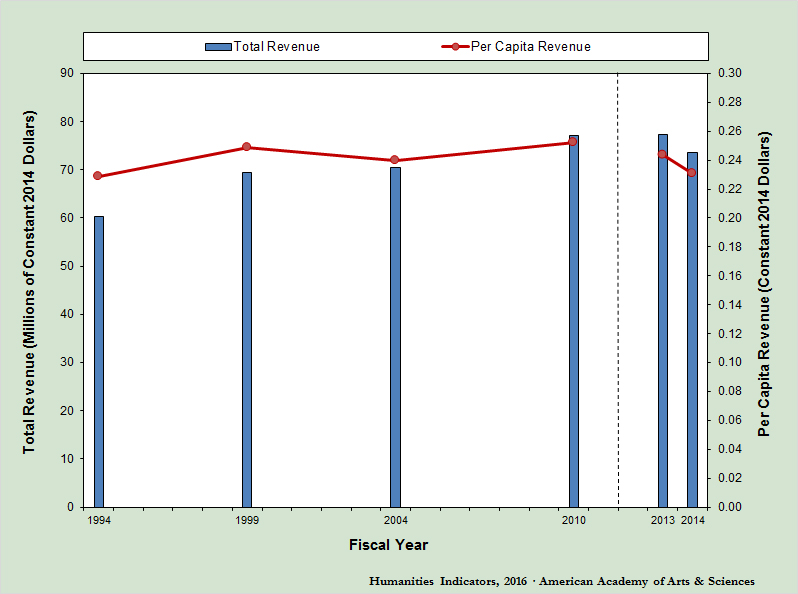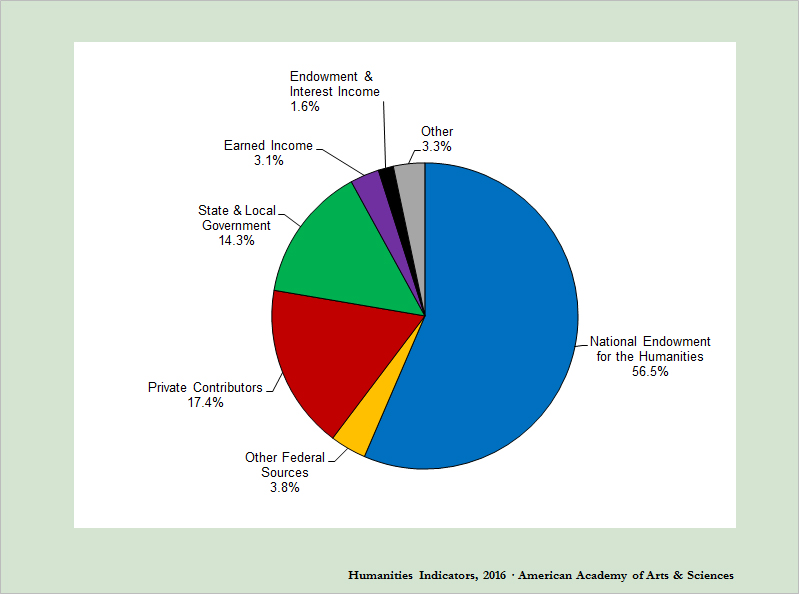State Humanities Council Revenues
- The Humanities Indicators’ analysis of IRS Form 990 data reveals that in 2010, the 50 state humanities councils and the council for the District of Columbia reported a total of $77 million in revenues (2014 dollars), which, once inflation is taken into account, represents a 28% increase over the 1994 level Indicator IV-05a; 1994 is the first year for which data are available for these councils; the five jurisdictional councils—American Samoa, Guam, Puerto Rico, the Virgin Islands, and the Northern Marianas—are not included because data are not available for all years). Over this same time period, the councils’ per capita revenues rose from 23 cents to 25 cents.
- For more recent years, the Federation of State Humanities Councils’ Income Survey is the most reliable and accessible source of data on council revenues.2 In 2014, the 50 state humanities councils and the council for the District of Columbia reported a total of $73.6 million in revenues (2014 dollars), which, once inflation is taken into account, represents a 4.7% decrease from the 2013 level . The councils’ per capita revenues were 23 cents in 2014, down approximately one cent from the previous year.
- The 2014 revenues of individual councils ranged from the $6.7 million reported by Virginia to Delaware’s $661,727 (Indicator IV-05b). Virginia is somewhat of an outlier; its revenues are more than twice as great as that of the Alaska council, the next best-resourced organization among the state/DC councils. The councils’ median 2014 revenue level was $1.1 million.
- In 2014, per capita funding levels ranged from six cents for the California council to over a dollar for the District of Columbia, Vermont, and Wyoming councils. At $4.50, Alaska’s per capita revenues were the highest in the nation. The median state per capita revenue level was 30 cents.
- The bulk of councils’ 2014 funding, 60.3%, was from the federal government, nearly all from the National Endowment for the Humanities (Indicators IV-05c and IV-05d; see “About the Data” for a description of the formula by which the National Endowment for the Humanities allocates funding to these organizations).3 Private contributors supplied the next largest share of council revenue, 17.4%. Councils received just over 14% of their funding from state and local governments, and earned approximately 3% via projects and sales.
Endnotes
- 2The “total income” values yielded by the Federation of State Humanities Councils’ Income Survey, the source of the data for years 2013 and 2014, are not strictly comparable to the “total revenue” figures from councils’ IRS Form 990s, which are the source for the totals given for earlier years. The Form 990–based totals exclude revenues used to cover certain types of expenses, and thus they tend to be somewhat lower than the survey totals. For this reason, the Humanities Indicators has constructed a new trend line beginning in 2013. This break-in-trend is represented on the graph by a broken line segment.
- 3This is in contrast with state arts agencies, the bulk of whose funding comes from state governments.
IV-05a: State Humanities Council Revenues, Total and Per Capita, Fiscal Years 1994–2014 (Adjusted for Inflation)*

* Excludes revenues of the territorial/jurisdictional councils of American Samoa, Guam, the Northern Mariana Islands, Puerto Rico, and the Virgin Islands because complete data were not available for these areas. The broken line segment indicates that the values for 2013 and 2014 are not strictly comparable to those for earlier years. See “About the Data” for details.
Source: For years 1994–2004: Urban Institute, National Center for Charitable Statistics (NCCS); data were compiled by NCCS from the Internal Revenue Service Form 990 Return Transaction Files. Form 990 data for the year 2010 were compiled by the Humanities Indicators from scanned 990s provided online by Guidestar. The 2010 revenue figure for West Virginia was drawn from the Federation of State Humanities Councils’ annual income survey, because a Form 990 for the state could not be obtained via Guidestar. For years 2013–2014: Federation of State Humanities Councils, 2013 and 2014 Income Survey. Funding amounts were adjusted for inflation using the Gross Domestic Product Implicit Price Deflators produced by the U.S. Department of Commerce’s Bureau of Economic Analysis. The population data used to calculate per capita amounts were produced by the Population Estimates Division of the U.S. Census Bureau.
The “total income” values yielded by the Federation of State Humanities Councils’ Income Survey, the source of the data for years 2013 and 2014, are not strictly comparable to the “total revenue” figures from councils’ IRS Form 990s, which are the totals given for earlier years. The Form 990–based totals exclude revenues used to cover certain types of expenses, and thus they tend to be somewhat lower than the survey totals. For this reason, the Humanities Indicators has constructed a new trend line beginning in 2013. This break-in-trend is represented on the graph by a broken line segment. The National Endowment for the Humanities (NEH) provides each of the state humanities councils with an annual supporting grant through its Federal/State Partnership program. The funds are allocated according to a legislatively mandated formula, which directs $200,000 to every council, with the remainder of the appropriated monies being distributed in the following manner:
- 44% is allocated equally among councils that serve a population of 200,000 or more;
- 22% is allocated to all councils according to population; and
- 34% is allocated to councils according to the wishes of the NEH chairperson.
- Councils also receive discretionary (nonformula) funding from the NEH. In addition, councils receive funding from the NEH in the form of matching grants and are eligible to apply for funding under the NEH’s competitive grant programs. NEH is not the only source of council funding. Some councils receive monies from other federal sources, and most are funded by their state governments. Most councils also receive at least some funding from private organizations (corporations or foundations) and/or individuals. Councils also raise funds through special projects or sales. The 56 councils are governed by volunteer boards composed of humanities scholars and members of the general public and receive the majority of their funding from the federal government. While the United States is home to a variety of humanities-focused organizations, councils are the focus of their own indicator because they are the primary channel through which the federal government provides resources to states for the purpose of making the humanities accessible to the general public.
IV-05b: Humanities Council Revenues, by State (Including the District of Columbia), Fiscal Year 2014*
Copy link* Excludes revenues of the territorial/jurisdictional councils of American Samoa, Guam, the Northern Mariana Islands, Puerto Rico, and the Virgin Islands because complete data were not available for these areas.
Source: Federation of State Humanities Councils, 2014 Income Survey.
The National Endowment for the Humanities (NEH) provides each of the state humanities councils with an annual supporting grant through its Federal/State Partnership program. The funds are allocated according to a legislatively mandated formula, which directs $200,000 to every council, with the remainder of the appropriated monies being distributed in the following manner:
- 44% is allocated equally among councils that serve a population of 200,000 or more;
- 22% is allocated to all councils according to population; and
- 34% is allocated to councils according to the wishes of the NEH chairperson.
Councils also receive discretionary (nonformula) funding from the NEH. In addition, councils receive funding from the NEH in the form of matching grants and are eligible to apply for funding under the NEH’s competitive grant programs. NEH is not the only source of council funding. Some councils receive monies from other federal sources, and most are funded by their state governments. Most councils also receive at least some funding from private organizations (corporations or foundations) and/or individuals. Councils also raise funds through special projects or sales. The 56 councils are governed by volunteer boards composed of humanities scholars and members of the general public and receive the majority of their funding from the federal government. While the United States is home to a variety of humanities-focused organizations, councils are the focus of their own indicator because they are the primary channel through which the federal government provides resources to states for the purpose of making the humanities accessible to the general public.
IV-05c: Sources of State Humanities Council Funding, Fiscal Year 2014

* Excludes revenues of the territorial/jurisdictional councils of American Samoa, Guam, the Northern Mariana Islands, Puerto Rico, and the Virgin Islands because complete data were not available for these areas.
Source: Federation of State Humanities Councils, 2014 Income Survey.
The National Endowment for the Humanities (NEH) provides each of the state humanities councils with an annual supporting grant through its Federal/State Partnership program. The funds are allocated according to a legislatively mandated formula, which directs $200,000 to every council, with the remainder of the appropriated monies being distributed in the following manner:
- 44% is allocated equally among councils that serve a population of 200,000 or more;
- 22% is allocated to all councils according to population; and
- 34% is allocated to councils according to the wishes of the NEH chairperson.
Councils also receive discretionary (nonformula) funding from the NEH. In addition, councils receive funding from the NEH in the form of matching grants and are eligible to apply for funding under the NEH’s competitive grant programs.
IV-05d: Sources of State Humanities Council Funding, Fiscal Year 2014 (State Comparison Tool)
Copy link* Excludes revenues of the territorial/jurisdictional councils of American Samoa, Guam, the Northern Mariana Islands, Puerto Rico, and the Virgin Islands because complete data were not available for these areas.
Source: Federation of State Humanities Councils, 2014 Income Survey.
The National Endowment for the Humanities (NEH) provides each of the state humanities councils with an annual supporting grant through its Federal/State Partnership program. The funds are allocated according to a legislatively mandated formula, which directs $200,000 to every council, with the remainder of the appropriated monies being distributed in the following manner:
- 44% is allocated equally among councils that serve a population of 200,000 or more;
- 22% is allocated to all councils according to population; and
- 34% is allocated to councils according to the wishes of the NEH chairperson.
Councils also receive discretionary (nonformula) funding from the NEH. In addition, councils receive funding from the NEH in the form of matching grants and are eligible to apply for funding under the NEH’s competitive grant programs.

